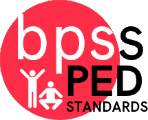BPS Physical Education Standards Book
PE Grade Levels
Grade 02
Young children arrive in 2nd Grade with widely varying knowledge in ....
2nd Grade Physical Education "I can ... statements"
PED-02.S1 Student demonstrates competency in a variety of motor skills and movement patterns.
- Locomotor Cluster:
- PED-02.S1.01: Skips using a mature pattern.
- PED-02.S1.02a: Runs with a mature pattern.
- PED-02.S1.02b: Travels showing differentiation between jogging and sprinting
- PED-02.S1.03: Demonstrates four of the five critical elements for jumping and landing in a horizontal plane using a variety of one- and two-foot take-offs and landings
- PED-02.S1.04: Demonstrates four of the five critical elements for jumping and landing in a vertical plane
- PED-02.S1.05: Performs a teacher and/or studentdesigned rhythmic activity with correct response to simple rhythms
- Non Locomotor (stability) Cluster:
- PED-02.S1.07a: Balances on different bases of support, combining levels and shapes
- PED-02.S1.07b: Balances in an inverted position with stillness and supportive base.
- PED-02.S1.08: Transfers weight from feet to different body parts/bases of support for balances and/or travel.
- PED-02.S1.09: Rolls in different directions with either a narrow or curled body shape.
- PED-02.S1.10: Differentiates among twisting, curling, bending and stretching actions.
- PED-02.S1.11: Combines balances and transfers into a three-part sequence (i.e., rhythmic movement, gymnastics).
- Manipulative Cluster:
- PED-02.S1.13: Throws underhand using a mature pattern.
- PED-02.S1.14: Throws overhand demonstrating two of the five critical elements of a mature pattern.
- PED-02.S1.16: Catches a self-tossed or well thrown large ball with hands, not trapping or cradling against the body.
- PED-02.S1.17a: Dribbles in self-space with dominant hand demonstrating a mature pattern.
- PED-02.S1.17b: Dribbles using the dominant hand while walking in general space.
- PED-02.S1.18: Dribbles with the feet in general space with control of ball and body.
- PED-02.S1.21: Uses a continuous running approach and kicks a moving ball, demonstrating three of the five critical elements of mature pattern.
- PED-02.S1.22: Volleys an object upward with consecutive hits.
- PED-02.S1.24: Strikes an object upward with a shorthandled implement, using consecutive hits
- PED-02.S1.25: Strikes a ball off a tee or cone with a bat, using correct grip and side-orientation/proper body orientation.
- PED-02.S1.27a: Jumps a self-turned rope consecutively forward and backward, with a mature pattern.
- PED-02.S1.27b: Jumps a long rope five times consecutively with skilled turners.
PED-02.S2 Applies knowledge of concepts, principles, strategies and tactics related to movement and performance.
-
- PED-02.S2.01: Combines locomotor skills in general space to a rhythm.
- PED-02.S2.02: Combines shapes, levels and pathways into simple travel, rhythmic movement and gymnastics sequences.
- PED-02.S2.03: Varies time and force with gradual increases and decreases (e.g., teacher control of increase/decrease through use of drum, shaker, tambourine).
PED-02.S3 Demonstrates the knowledge and skills to achieve and maintain a health-enhancing level of physical activity and fitness.
-
- PED-02.S3.01: Describes largemotor and/or manipulative physical activities for participation outside physical education class (e.g., recess, before and after school, at home, at the park, with friends, with the family).
- PED-02.S3.02: Actively engages in physical education class in response to instruction and practice.
- PED-02.S3.03a: Recognizes the use of the body as resistance (e.g., holds body in plank position, animal walks) for developing strength. (
- PED-02.S3.03b: Identifies physical activities that contribute to fitness.
- PED-02.S3.06: Recognizes the importance of balancing nutrition and physical activity.
PED-02.S4 Exhibits responsible personal and social behavior that respects self and others.
-
- PED-02.S4.01: Practices skills with minimal teacher prompting.
- PED-02.S4.02: Accepts responsibility for class protocols with behavior and performance actions.
- PED-02.S4.03: Accepts specific corrective feedback from the teacher.
- PED-02.S4.04: Works independently with others in partner environments.
- PED-02.S4.05: Recognizes the role of rules and etiquette in teacher-designed physical activities.
- PED-02.S4.06a: Works independently and safely in physical education.
- PED-02.S4.06b: Works safely with physical education equipment.
PED-02.S5 Recognizes the value of physical activity for health, enjoyment, challenge, self-expression and/or social interaction.
-
- PED-02.S5.01: Recognizes the relationship between physical activity and good health.
- PED-02.S5.02: Compares physical activities that bring confidence and challenge
- PED-02.S5.03: Identifies physical activities that provide self-expression (e.g., rhythmic activities/dance, gymnastics routines, practice tasks in game environments).
